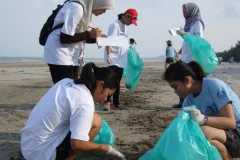How You Can Help the Ocean

The threats faced by our ocean planet may seem overwhelming. In the face of pollution, climate change, overfishing, and other daunting problems, what you can do on your own may seem like a drop in the bucket. But if we begin working together now, we can make a huge difference. Here are some ways to get started:
Make the Connection
The first step in making a difference is learning about the ocean and how your actions have an impact. Keep reading to learn everyday things you can do to help protect and restore the seas. And don't forget to share what you've learned with friends and family.
Be Water Wise
All water on Earth is connected. Even if you don't live near the coast, water that goes down your drain or runs off from your yard can eventually make its way into the ocean. The Mississippi River, for example, is like a giant funnel collecting water from thousands of smaller rivers and streams. It drains 41 percent of the continental U.S. into the Gulf of Mexico. Because of run-off from farms and fields, the Gulf now experiences large annual dead zones, or areas with so little oxygen that sea life cannot survive there. You can help keep the ocean—and other waterways—healthy by reducing your family's use of chemicals inside and out.
- In the yard: Use as little fertilizer as possible. Fertilizers (including manure) add nutrients to the soil and water that can be carried downstream when it rains. Extra nutrients can cause harmful algae blooms that disrupt the ocean's natural balance. Try to grow plants suited to the local natural conditions. They will grow hardily with fewer chemicals.
- On the table: Look for fruits and vegetables that are grown without pesticides (and don't spray them in your own garden). Pesticides contain toxins that can run off into the sea and harm marine life. Also look for produce grown in season and close to where you live. A lot of energy is wasted in transporting foods from far away or growing them in greenhouses at the wrong time of year. See tip number five below to find out how our energy use affects the ocean.
- In the house: Choose non-toxic cleaning products and low-phosphate detergents. Many household chores can be done with simple ingredients like vinegar, baking soda, or lemon juice. Visit Consumer Reports' Greener Choices page for suggestions.
Trim Down Trash
- Ditch the disposable lifestyle: Make a point to use reusable bags, beverage cups, and food containers. When you must use disposable items, reuse or recycle them whenever possible.
- Garbage patrol: Never litter (inland, on the beach, or from a boat), and participate in beach or waterway clean ups to help stop the flow of trash into the ocean.
Be Fish Friendly
- Watch what you eat: Demand sustainable seafood at the supermarket and in your favorite restaurants. Always know what to order by downloading a sustainable seafood guide. And when fishing for your own seafood, make sure you follow all local catch limits.
- Choose pets carefully: If you have a salt-water aquarium, make sure you ask where and how the animals you buy were collected. Look for the Marine Aquarium Council's Certification in pet stores to find animals that were carefully harvested and well cared for. And never release an unwanted pet into the ocean or any waterway. Organisms that don't belong can crowd out the locals and disrupt the ecosystem.
- Select sea-friendly souvenirs: Steer clear of jewelry, mementos, and products made from marine animals or animal parts, including shells and—especially—coral.
Cut Carbon
- Power down: Making little changes in the way we live can go a long way to reducing energy use—and carbon emissions. Try drying laundry on a clothesline or rack instead of in the dryer. Walk, bike, take the bus, or carpool to work or school. Replace light bulbs and older appliances with newer, more efficient models.
- Switch sources: Not all energy comes from burning fossil fuels. Clean, unlimited energy can come from the sun, wind, or heat deep in the Earth (called geothermal). Call your power company or visit the Department of Energy's Buying Green Power page to find alternative energy programs near you.
Recreate Responsibly
- On the sand: When walking on sand dunes, be careful of any grasses and plants growing there. Living plants help hold sand in place. Dead plants and seaweed provide fertilizer. Both should be left alone.
- In the shallows: On rocky shores, the shallow "tidepools" that are exposed when the tide is out, can be a great place to look for interesting marine life. But be careful not to trample on these fragile critters and their homes. Look, but don't touch.
- Near the reef: When snorkeling or diving, never touch the reef! Corals and other animals are fragile and easily killed by a grasping hand or careless flipper. Also never feed or handle marine animals.
- In open water: When boating, be very careful where you anchor. Anchors can scar reefs and rip out seagrass beds, which provide food and shelter for many species. Where permanent anchoring buoys are provided, use them.

